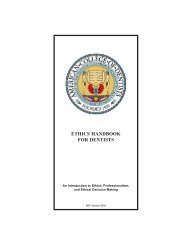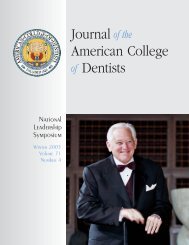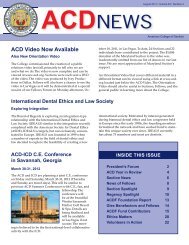Journal of the American College of Dentists
Journal of the American College of Dentists
Journal of the American College of Dentists
You also want an ePaper? Increase the reach of your titles
YUMPU automatically turns print PDFs into web optimized ePapers that Google loves.
Manuscript<br />
Retention <strong>of</strong> Underrepresented Minority Students<br />
in Dental School<br />
One Dental School’s Story<br />
40<br />
Ernestine S. Lacy, DDS<br />
Barbara H. Miller, DDS<br />
Sheryl A. Hornback, MA<br />
Ann L. McCann, PhD<br />
Jayne S. Reuben, PhD<br />
Abstract<br />
There is a large disparity between <strong>the</strong> proportions<br />
<strong>of</strong> African-<strong>American</strong>s, Hispanics, and<br />
Native <strong>American</strong>s in <strong>the</strong> general population<br />
and in <strong>the</strong> dental pr<strong>of</strong>ession. While <strong>the</strong>se<br />
underrepresented minorities (URMs) as a<br />
group make up almost 30% <strong>of</strong> <strong>the</strong> United<br />
States population, <strong>the</strong>y constitute only about<br />
6% <strong>of</strong> <strong>the</strong> nation’s dentists. Eliminating this<br />
disparity is important in addressing access<br />
to care for underrepresented groups. Texas<br />
A&M Health Science Center Baylor <strong>College</strong><br />
<strong>of</strong> Dentistry (TAMHSC-BCD) enrolled greater<br />
numbers and proportions <strong>of</strong> URM students<br />
than any o<strong>the</strong>r non-minority school from<br />
2006-2010. Strategies used to achieve this<br />
level <strong>of</strong> diversity include a Whole File Review<br />
process; career awareness activities for elementary,<br />
junior high and high school students;<br />
and academic enrichment programs for college<br />
students and college graduates. Retaining<br />
and graduating URM students is just as<br />
important as enrolling <strong>the</strong>m. TAMHSC-BCD’s<br />
retention rate over <strong>the</strong> last five years is 95.7%<br />
for all students and 92.5% for URM students.<br />
A wide range <strong>of</strong> services aids in <strong>the</strong> retention<br />
process. These services are available to all<br />
students and include monitoring <strong>of</strong> students’<br />
academic performance followed up with<br />
academic advisement as appropriate, peer<br />
tutoring, an alternative five-year curriculum,<br />
pr<strong>of</strong>essional psychological counseling, pr<strong>of</strong>essional<br />
learning assessments, social support;<br />
and mentoring through student organizations.<br />
The retention program at TAMHSC-BCD can<br />
serve as a model for o<strong>the</strong>r dental and o<strong>the</strong>r<br />
health pr<strong>of</strong>essions schools seeking ways to<br />
ensure <strong>the</strong> academic success <strong>of</strong> <strong>the</strong>ir URM<br />
students. The more <strong>of</strong> <strong>the</strong>se students we<br />
enroll and graduate, <strong>the</strong> more <strong>the</strong> problem<br />
<strong>of</strong> access to dental care is addressed.<br />
There is a large disparity between<br />
<strong>the</strong> percentages African-<strong>American</strong>s,<br />
Hispanics, and Native <strong>American</strong>s<br />
in <strong>the</strong> general population and <strong>the</strong> percentages<br />
<strong>of</strong> those groups in <strong>the</strong> dental<br />
pr<strong>of</strong>ession. While <strong>the</strong>se underrepresented<br />
minorities (URMs) as a group make up<br />
almost 30% <strong>of</strong> <strong>the</strong> United States population,<br />
<strong>the</strong>y constitute only about 6% <strong>of</strong><br />
<strong>the</strong> nation’s dentists (<strong>American</strong> Dental<br />
Association, 2004; U.S. Census Bureau,<br />
2010). For years, <strong>the</strong> <strong>American</strong> Dental<br />
Education Association has been diligently<br />
working with United States dental schools<br />
to reduce and, ultimately, eliminate this<br />
disparity by increasing <strong>the</strong> diversity <strong>of</strong><br />
<strong>the</strong> students that are admitted. However,<br />
<strong>the</strong> percentage <strong>of</strong> URMs entering dental<br />
school continues to remain significantly<br />
below that <strong>of</strong> <strong>the</strong> general population.<br />
Figure 1 shows <strong>the</strong> enrollment <strong>of</strong> firstyear<br />
URM dental students in <strong>the</strong> United<br />
States dental schools for <strong>the</strong> 2010–2011<br />
academic year compared to <strong>the</strong> URMs in<br />
<strong>the</strong> general United States population.<br />
Why is it important to increase <strong>the</strong><br />
racial and ethnic diversity <strong>of</strong> dental<br />
students and, ultimately, <strong>the</strong> dental<br />
workforce? First, training racially and<br />
ethnically diverse healthcare providers<br />
is one <strong>of</strong> <strong>the</strong> keys to addressing <strong>the</strong><br />
problems <strong>of</strong> barriers to dental care. The<br />
Surgeon General’s Report on Oral Health<br />
points out that racial and ethnic minorities<br />
experience a higher level <strong>of</strong> dental<br />
problems than o<strong>the</strong>rs (Sinkford et al,<br />
2001). In a study conducted in California,<br />
communities with high percentages <strong>of</strong><br />
African-<strong>American</strong> and Hispanic residents<br />
were far more likely to have a shortage<br />
<strong>of</strong> physicians than were o<strong>the</strong>r communities.<br />
In addition, Hispanic physicians<br />
were more likely to care for Hispanic<br />
patients and African-<strong>American</strong> physicians<br />
for African-<strong>American</strong> patients. Hispanic<br />
physicians treated <strong>the</strong> greatest proportion<br />
<strong>of</strong> uninsured patients, while African-<br />
<strong>American</strong> physicians served more<br />
Medicaid patients (Komaromy et al,<br />
1996). This finding was corroborated<br />
from two large national surveys <strong>of</strong><br />
physicians that suggested that minoritygroup<br />
and female physicians were more<br />
likely than o<strong>the</strong>rs to serve minority,<br />
poor, and Medicaid patients (Cantor et<br />
al, 1996). A 2001 study <strong>of</strong> practice areas<br />
<strong>of</strong> African-<strong>American</strong> dentists in Texas<br />
showed that <strong>the</strong>se dentists commonly<br />
serve African-<strong>American</strong> patients (Solomon<br />
et al, 2001). Fur<strong>the</strong>rmore, “not only are<br />
minority practitioners more likely than<br />
<strong>the</strong>ir White counterparts to practice in<br />
underserved minority communities, but<br />
minority practitioners, educators, and<br />
researchers can influence o<strong>the</strong>r health<br />
pr<strong>of</strong>essionals to be more culturally sensi-<br />
Dr. Lacy is <strong>the</strong> Director <strong>of</strong><br />
Student Development at<br />
TAMHSC-BCD; eslacy@bcd.<br />
tamhsc.edu. Drs. Miller and<br />
McCann and Ms. Hornback<br />
are also at TAMHSC-BCD in<br />
<strong>the</strong> capacities <strong>of</strong> Executive<br />
Director <strong>of</strong> Recruitment and<br />
Admissions, Director <strong>of</strong><br />
Planning and Assessment, and<br />
Educational Specialist, respectively;<br />
Dr. Reuben is a clinical<br />
associate pr<strong>of</strong>essor at <strong>the</strong><br />
University <strong>of</strong> South Carolina<br />
School <strong>of</strong> Medicine.<br />
2011 Volume 78, Number 4





